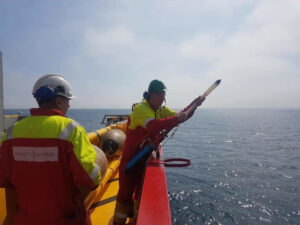Companies involved in closed bell or saturation diving tasks in the Offshore sector should carefully evaluate the method to allow divers under pressure to be evacuated safely, considering environmental conditions and geographical areas.
In the event of a serious accident (vessels or facilities evacuation) the Self-Propelled Hyperbaric Lifeboat (SPHL) can be used to rescue divers while they are in saturation diving system as an alternative to the Hyperbaric Rescue Chamber (HRC). This vehicle allow divers a comfortable and safe decompression procedure.
In cases of vessel abandonment, the SPHL vehicle can be mated to the bottom or side of the saturation diving system and it will be ready to be launched from a suitable Launch and Recovery System (LARS). The SPHL are vehicles capable of moving quickly from an accident site (sinking of a vessel, fires or explosions of oil and gas installations) and reach a safe area where it will be recovered by a salvage vessel or port facility. The vehicle in the water can be easily towed by a salvage vessel or recovered onboard through a stern ramp or stinger recovery system and devices such as the davit-based LARS project by Caley company. The SPHL can be mated also to a Hyperbaric Rescue Facility (HRF) system side.
As contained in the DNV document, the SPHL must be divided into at least two compartments, one for the crew or diving team and one for divers. It provides spaces for divers and other diving team members (LST, Dive Supervisor), auxiliary equipment, engine, generator, the hyperbaric unit control console, gas cylinders and the LSS (Life Support System). The SPHL is equipped as a saturation diving system or HRC, includes a communication system that allows dive team to communicate with the diver compartment and vice versa, a sanitation system, a fire alarm and a fire detection and extinction system. The engine room will be located in an adequate area, separated from the people compartments.
The SPHL autonomy capacity is equivalent to the time required to complete the decompression. The SPHLs are built in different sizes, they are able to accommodate up to 24 divers.
Analysis of past accidents in offshore oil and gas or renewable energy operations could facilitate the choice of suitable equipment dedicated to evacuation in the event of sinking, fire and explosion events.
Jessica Moro
DSO
Hyperbaric Rescue Chamber – hyperbaric unit, part of saturtation system, specially designed to allow divers survival in case of vessel evacuation. It floats and can be towed or recovered by rescue vessels.
Procedure of connection of two saturation modules.
Type of crane that allows to lift, mobilize and lower diving equipment, such as diving bells, SPHL, remote-controlled vehicles, into the water.
Det Norske Veritas – accredited certification body and ship classification society with headquarters in Høvik, Norway. It provides services for several industries including maritime, oil & gas and renewable energy, and publishes standards and regulations.
Life Support System – System of equipment that allows life inside a habitat, in a hostile environment, such as in space and hyperbaric/saturation activities.
Image
Cover: Photo of an SPHL, by courtesy of MIMIR MARINE.

